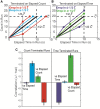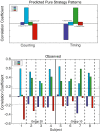Evidence for a Mixed Timing and Counting Strategy in Mice Performing a Mechner Counting Task
- PMID: 31293396
- PMCID: PMC6603078
- DOI: 10.3389/fnbeh.2019.00109
Evidence for a Mixed Timing and Counting Strategy in Mice Performing a Mechner Counting Task
Abstract
Numerosity, or the ability to understand and distinguish between discrete quantities, was first formalized for study in animals by Mechner (1958a). Rats had to press one lever (the counting lever) n times to arm food release from pressing a second lever (the reward lever). The only cue that n presses had been made to the counting lever was the animal's representation of how many times it had pressed it. In the years that have passed since, many researchers have modified the task in meaningful ways to attempt to tease apart timing-based and count-based strategies. Strong evidence has amassed that the two are fundamentally different and separable skills but, to date, no study has effectively examined the differential contributions of the two strategies in Mechner's original task. By examining performance mid-trial and correlating it with whole-trial performance, we were able to identify patterns of correlation consistent with counting and timing strategies. Due to the independent nature of these correlation patterns, this technique was uniquely able to provide evidence for strategies that combined both timing and counting components. The results show that most mice demonstrated this combined strategy. This provides direct evidence that mice can and do use numerosity to complete Mechner's original task. A rational agent with fallible estimates of both counts made and time elapsed in making them should use both estimates when deciding when to switch to the second lever.
Keywords: counting; mice; numerosity; operant conditioning; timing.
Figures






Similar articles
-
Assessing the performance of brushtail possums (Trichosurus vulpecula) on the Mechner counting procedure.Anim Cogn. 2022 Dec;25(6):1493-1503. doi: 10.1007/s10071-022-01630-8. Epub 2022 May 7. Anim Cogn. 2022. PMID: 35524865
-
Numerical averaging in mice.Anim Cogn. 2021 May;24(3):497-510. doi: 10.1007/s10071-020-01444-6. Epub 2020 Nov 4. Anim Cogn. 2021. PMID: 33150473
-
Mice can count and optimize count-based decisions.Psychon Bull Rev. 2016 Jun;23(3):871-6. doi: 10.3758/s13423-015-0957-6. Psychon Bull Rev. 2016. PMID: 26463617
-
Probabilistic numerical discrimination in mice.Anim Cogn. 2016 Mar;19(2):351-65. doi: 10.1007/s10071-015-0938-1. Epub 2015 Nov 26. Anim Cogn. 2016. PMID: 26612627
-
Striatal dopamine release in the rat during a cued lever-press task for food reward and the development of changes over time measured using high-speed voltammetry.Exp Brain Res. 2005 Sep;166(1):137-46. doi: 10.1007/s00221-005-2345-3. Epub 2005 Jul 19. Exp Brain Res. 2005. PMID: 16028033
Cited by
-
Mice make temporal inferences about novel locations based on previously learned spatiotemporal contingencies.Anim Cogn. 2023 Jun;26(3):771-779. doi: 10.1007/s10071-022-01715-4. Epub 2022 Nov 17. Anim Cogn. 2023. PMID: 36394657
-
Bar press durations as a reliable and robust measure of frustration-related operant behavior: Sensitivity to incentive downshift and dose-response paradigms.PLoS One. 2023 Dec 21;18(12):e0296090. doi: 10.1371/journal.pone.0296090. eCollection 2023. PLoS One. 2023. PMID: 38127939 Free PMC article.
-
Assessing the performance of brushtail possums (Trichosurus vulpecula) on the Mechner counting procedure.Anim Cogn. 2022 Dec;25(6):1493-1503. doi: 10.1007/s10071-022-01630-8. Epub 2022 May 7. Anim Cogn. 2022. PMID: 35524865
-
Disparate processing of numerosity and associated continuous magnitudes in rats.Sci Adv. 2024 Feb 23;10(8):eadj2566. doi: 10.1126/sciadv.adj2566. Epub 2024 Feb 21. Sci Adv. 2024. PMID: 38381814 Free PMC article.
-
Numerical averaging in mice.Anim Cogn. 2021 May;24(3):497-510. doi: 10.1007/s10071-020-01444-6. Epub 2020 Nov 4. Anim Cogn. 2021. PMID: 33150473
References
-
- Fetterman J. G. (1993). Numerosity discrimination: both time and number matter. J. Exp. Psychol. Anim. Behav. Process 19, 149–164. - PubMed
Grants and funding
LinkOut - more resources
Full Text Sources

